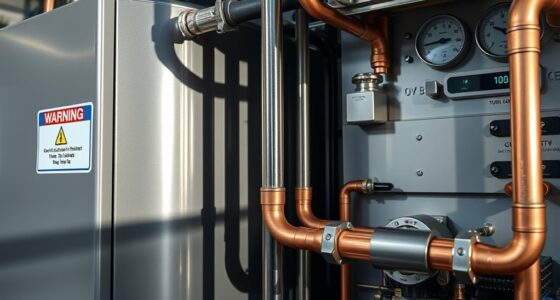To design the perfect home cold plunge, focus on combining efficient water filtration with proper insulation. Choose high-quality filters and regular maintenance to keep water clean and safe, while insulating the tub to maintain cold temperatures and reduce energy use. Proper placement of filtration units and insulating covers will make upkeep easier and extend the system’s life. Keep these essentials in mind, and you’ll create a safe, energy-efficient wellness retreat—get ready to explore even more.
Key Takeaways
- Choose a well-insulated tub with high-quality foam or spray insulation to maintain cold temperatures efficiently.
- Install an effective water filtration system with replaceable filters to keep water clean and minimize chemical use.
- Position the filtration unit nearby for easy access and routine maintenance.
- Add insulating covers and seal all edges to prevent heat loss and condensation.
- Regularly maintain filters and monitor water quality to ensure long-term safety and performance.

Creating a cold plunge setup at home is an achievable way to enhance your wellness routine, but it requires careful planning and design. One of the most critical aspects is guaranteeing the water stays clean and safe, which makes water filtration systems essential. A good filtration setup, such as a combination of filters and sanitizers, helps remove debris, bacteria, and algae, keeping the water crisp and hygienic for regular use. You should consider installing a reliable pump and filtration unit compatible with your plunge tub size. Regular maintenance, like replacing filters and monitoring water quality, is crucial to prevent buildup and ensure the water remains safe. Additionally, choosing a filtration system that minimizes chemical use promotes a healthier environment and enhances your wellness experience.
Effective water filtration and regular maintenance keep your home cold plunge safe and hygienic.
Another key element is insulation. Proper insulation techniques are necessary to maintain cold temperatures efficiently and prevent heat loss, especially if you plan to keep your plunge setup outdoors or in a less temperature-controlled space. You can insulate the sides and bottom of your tub using foam boards, spray foam, or specialized insulating blankets. The goal is to create a barrier that minimizes heat transfer, so your water stays cold longer without excessive energy consumption. If your setup is indoors, insulation also helps control humidity and condensation, protecting surrounding surfaces from moisture damage. Remember, the more effective your insulation, the less often you’ll need to run your cooling system, saving energy and costs.
When designing your home cold plunge, think about combining water filtration and insulation techniques seamlessly. For example, if you’re using a wooden barrel or custom-built tub, ensure it’s lined or wrapped with insulating material, then sealed properly to prevent leaks. Integrate the filtration system nearby, so it’s easy to access for maintenance without disrupting your setup. Consider installing a cover made of insulating material to trap cold temperatures overnight or when not in use, further reducing heat loss. Planning these elements upfront makes maintenance easier and guarantees consistent performance. Incorporating proper water circulation techniques can also improve water quality and efficiency.
Incorporating high-quality water filtration and insulation techniques into your cold plunge setup may require an initial investment, but the long-term benefits—clean water, energy efficiency, and consistent cold temperatures—are well worth it. These focus areas ensure your setup remains functional, safe, and comfortable, allowing you to enjoy the full wellness benefits of cold immersion regularly. With thoughtful design and proper equipment, creating a personalized cold plunge at home becomes a straightforward project that elevates your health routine and offers a refreshing escape whenever you need it.
Frequently Asked Questions
What Is the Ideal Water Temperature for a Cold Plunge?
The ideal water temperature for a cold plunge is typically between 50°F and 59°F (10°C to 15°C). You should focus on maintaining water quality and precise temperature control to guarantee safe, effective plunges. Regularly monitor the temperature and clean your setup to prevent bacteria buildup. Staying within this range helps maximize benefits like muscle recovery and circulation while keeping your cold plunge safe and enjoyable.
How Often Should I Clean and Maintain My Cold Plunge?
You should clean and maintain your cold plunge at least once a week to keep it pristine. Regularly check water filtration and chemical balancing to prevent bacteria buildup and algae growth. If you notice cloudiness or odors, don’t wait—delve into deeper cleaning immediately. Staying vigilant ensures your plunge remains safe and inviting, making every dip a revitalizing, worry-free experience. Keep up with maintenance, and your cold plunge will reward you with peak performance.
Can I Use a Hot Tub or Bathtub as a Cold Plunge?
Yes, you can use a hot tub or bathtub as a cold plunge, but be aware of the risks. Hot tubs offer benefits like relaxation and muscle relief, but they’re usually too warm for cold plunges. Bathtubs are more versatile, but using hot water can cause risks like skin irritation or fainting if not cooled properly. Always guarantee you can safely lower the temperature and limit your time in the water.
What Safety Precautions Should I Take During Cold Plunges?
Oh, the irony of risking hypothermia just to enjoy cold plunges! You should always stay aware of hypothermia prevention by limiting your time in cold water and monitoring your body’s responses. Keep emergency preparedness nearby—have a phone, warm blankets, and a heat source ready. Never plunge alone, and listen to your body. Safety first ensures your invigorating routine doesn’t turn into a risky, icy ordeal.
How Long Should Each Cold Plunge Session Last?
You should aim for cold plunge sessions lasting between 1 to 5 minutes, following the duration guidelines to avoid overexposure. Start with shorter sessions and gradually increase as your body adapts. Typically, a few sessions per week are sufficient, but listen to your body’s signals. Always prioritize safety, and don’t push beyond your comfort zone, especially if you’re new to cold plunges.
Conclusion
Creating your perfect cold plunge setup at home isn’t just about the cool water — it’s about embracing a ritual that awakens your body and sharpens your mind. Imagine stepping into your own oasis, where every dip is a reminder that you hold the power to refresh, reset, and conquer. So, plunge in with confidence, knowing your sanctuary is just a few thoughtful choices away. After all, isn’t life too short not to enjoy a little chill?









